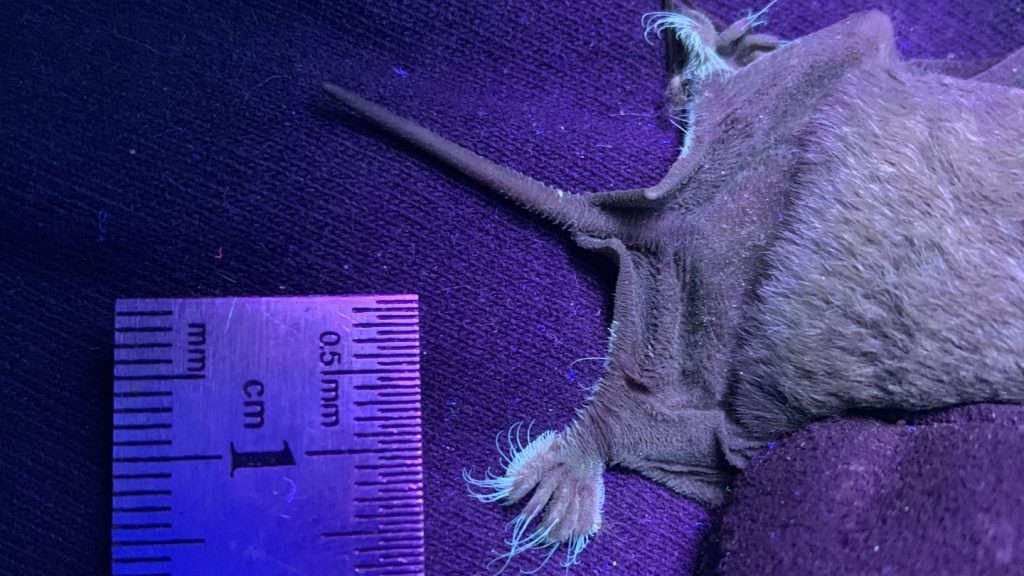Biologist Fernando Gual-Suárez and his colleagues observed a unique phenomenon while studying Mexican free-tailed bats in Mexico City in January 2021. They discovered that the bats had glow-in-the-dark toes, which stood out under a UV light. This discovery was unexpected as their original goal was to track the movement of the bats between two locations using a special powder. Further investigation revealed that the glowing structures were present on live bats from different sites, as well as on museum specimens. This finding was considered significant in understanding the behavior and physiology of these bats.
Previous research has shown that photoluminescence occurs in various animals, such as wasps, platypuses, and tardigrades. While some animals glow entirely under UV light, Mexican free-tailed bats specifically have glow-in-the-dark toes. These bats, belonging to the Molossidae family, possess unique spoon-shaped bristles on their toes, which have puzzled scientists for some time. The purpose of the glowing toes remains unknown, but researchers speculate that they could play a role in nighttime communication, especially since these bats migrate long distances and live in large colonies. Further experimentation in a controlled environment is needed to understand the function of these glow-in-the-dark toes.
Morphologist Nancy Simmons, an expert on bats, points out that the presence of glow-in-the-dark toes in Mexican free-tailed bats adds to the mystery of the unique features found in this species. The research conducted by Gual-Suárez and his team is commended for comparing results from live animals to museum specimens to ensure that the findings were authentic to nature. This type of scientific inquiry helps in advancing our knowledge of the natural world and uncovering new and exciting discoveries. The glowing toes on Mexican free-tailed bats provide a new area of study for researchers interested in the ecology and behavior of these fascinating creatures.
Researcher Rodrigo Medellín, an ecologist at the National Autonomous University of Mexico, emphasizes the need for further laboratory studies to understand the significance of the glow-in-the-dark toes in Mexican free-tailed bats. The idea of creating a captive colony of these bats and examining the effects of shaving the bristles on their feet could provide valuable insights into the purpose of this unique adaptation. As nocturnal creatures that migrate long distances, it is plausible that the glowing toes serve a specific function related to their behavior and communication within the colony. This study represents just the beginning of a deeper exploration into the mysteries surrounding Mexican free-tailed bats and their glowing toes.
The discovery of glow-in-the-dark toes in Mexican free-tailed bats highlights the importance of ongoing research to unravel the complexities of the natural world. Understanding how these unique adaptations benefit the bats in their environment can provide valuable information for conservation efforts and wildlife management. Scientists continue to be intrigued by the diverse ways in which animals have evolved to survive and thrive in different ecosystems. By studying these fascinating phenomena, researchers can gain a deeper appreciation for the diversity and resilience of life on Earth and work towards protecting these species for future generations.
In conclusion, the observation of glow-in-the-dark toes in Mexican free-tailed bats by Biologist Fernando Gual-Suárez and his team represents a significant contribution to the field of bat biology. This unexpected discovery opens up new avenues for research and exploration into the behavior and physiology of these fascinating creatures. By conducting further experiments and investigations, scientists hope to unravel the mystery behind the purpose of these glow-in-the-dark toes and how they contribute to the survival and functioning of Mexican free-tailed bats in their natural habitat. This study serves as a reminder of the endless possibilities for discovery in the natural world and the importance of continued scientific inquiry into understanding the complexities of life on Earth.


